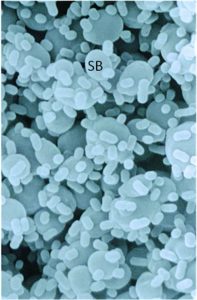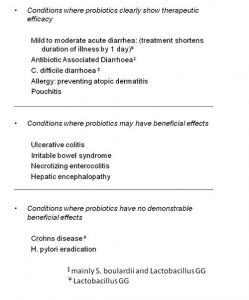Pre- and Probiotics in Clinical Practice: Towards a Rational Approach to their use in Clinical Practice
by Thomas M. Attard MD FAAP FACG
Consultant Paediatrician, Gastroenterologist
Mater Dei Hospital
Clinicians are increasingly involved with probiotics in the wake of society’s increased concern with the deleterious effects of antibiotics along with a trust towards more healthful foods and supplements. Pre- and probiotic agents however are not created equal and a familiarity with the key concepts and published literature is desirable.
The human gastrointestinal tract is a complex microenvironment that includes over 500 distinct species of bacteria, fungi and helminths and more than 100 trillion microorganisms. The resulting symbiotic relationship, the intestinal microbiome, goes largely unnoticed until major perturbations result in clinical manifestations which we are only recently starting to fully appreciate.
The concept of healthful foods is far from recent; indeed, in 1907 Metchinhoff published his observations on the increased longevity of Bulgarian peasants who consumed large quantities of sour milk containing what is now known to be Lactobacillus bulgaricus.1 He speculated that normal ageing might be reflective of an ‘autointoxication’ process through absorption of bacterial metabolites. Other workers, notably Henry Tissier, experimented with the use of Bifidobacterium in the treatment of infectious diarrhea, and later, in 1917, Alfred Nissle used a specific strain of E.coli to treat for Salmonellosis and Shigellosis.
Kollath in 1953 fist proposed the currently accepted definition of probiotics as ‘live microorganisms, which when consumed in adequate amounts, confer a health effect on the host.’ Prebiotics, on the other hand, are non-digestible fermented food components which allow specific changes, both in the composition and/or activity in the intestinal microflora, thereby stimulating the proliferation of beneficial bacteria and are therefore considered functional foods. They include carbohydrates, namely oligosaccharides, and dietary, including soluble, fiber. Prebiotics are in fact present in human breast milk and may play an important role in modulating infant immunologic maturation.
The exact mode of action of probiotics on human health is unknown; several putative mechanisms are supported by in-vitro observations. These include a direct antimicrobial effect by modifying the colonic microenvironment, secretion of antibacterial substances, competition for microbial nutrients and adhesion sites on the intestinal mucosa. Probiotics can also secrete antitoxins and may reverse some of the consequences of infection on the intestinal mucosa. Studies suggest that probiotics can modulate the immune system impacting the evolution of allergic and autoimmune disorders and reducing cell proliferation in cancer.
There is a bewildering range of potential pre- and probiotic agents, combinations and sources. The probiotic agents more extensively studied are lactobacilli (notably Lactobacillus GG), saccharomyces (S. boulardii), bifidobacteria, Escherichia coli and streptococci. Probiotics are marketed as medicinal products as well as healthful food additives example, in yogurts and as dietary supplements. The devil, even in the colon, lurks in the detail. In-vitro effects do not necessarily result in therapeutic efficacy. Indeed, despite reasoned therapeutic potential, probiotics have been shown to be deleterious in certain conditions, for example acute pancreatitis.3 Besides, the viability of individual probiotic agents in, for example, dairy products may be erratic2 and the strict pharmaceutical standards in terms of quality assurance that affect the efficacy of these agents are harder to enforce if they are classified as food supplements rather than true medicinals. There are also very clear differences in the efficacy of different probiotic agents and furthermore combinations of probiotic agents may not necessarily induce synergistic effects. Observations from well designed studies cannot be extrapolated to all probiotic agents, or indeed different preparations of the same agent. Indeed, probiotics have such varied characteristics that they cannot be regarded with a broad brush as in a class of drugs, for example, NSAIDs.
The recent clinical practice guidelines on the use of probiotics published by the Nutrition Committee of the North American Society of Pediatric Gastroenterology Hepatology and Nutrition (NASPGHAN) have high-lightened the complexity in the published literature supporting the use of these agents.4 Table 1 summarizes the conclusions of the working group based on the findings from the better designed, peer-reviewed, published studies.
Probiotics have shown clear efficacy in decreasing the overall duration of acute gastroenteritis as well as preventing nosocomial and community-acquired infectious diarrhea.5 Lactobacillus GG and S boulardii have specifically shown a significant impact in decreasing antibiotic associated diarrhea; a common accompaniment to broad spectrum, especially beta-lactam, antibiotic use.6 These agents are also useful in C. difficile colitis. E. Coli Nissle has been shown to have equivalent clinical efficacy to mesalazine in Ulcerative Colitis7 whereas the results in Crohn’s Disease with this and other agents have been inconclusive8 and these agents are therefore probably better avoided in this condition given the unclear relationship with small intestinal bacterial overgrowth. Probiotics have been extensively studied and show conflicting results in Irritable Bowel Syndrome in adults and Functional abdominal pain in children; however overall clinical benefit seems more likely9,10 and probiotics are often empirically used in these conditions. In children, probiotics have demonstrable efficacy in decreasing atopy, especially eczema.11 Although there are several additional potential clinical benefits to probiotic use, including other extraintestinal and antitumour effects; these claims are rarely supported by robust clinical trials.
Although probiotics and prebiotics have an exceptional safety profile with an extremely low risk of adverse reactions including opportunistic infection (probiotics are contraindicated in immunocompromised patients), the practicing clinician needs to labor toward an evidence-based use of these agents bearing in mind agent, preparation and dose-dependent efficacy.

Figure 1: Probiotic Mode of Action. Adherence of Escherichia coli serogroup 0H157 and Salmonella typhimurium mutant DT 104 to the surface of Saccharomyces boulardii

Figure 2: Use of Probiotics. Evidence obtained from prospective randomised controlled studies
References
Not related to ‘in 1917, Alfred Nissle used a specific strain of E.coli to treat for Salmonellosis and Shigellosis.’
References
Not related to ‘in 1917, Alfred Nissle used a specific strain of E.coli to treat for Salmonellosis and Shigellosis.’

